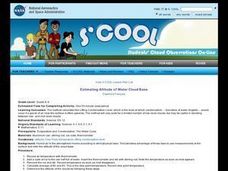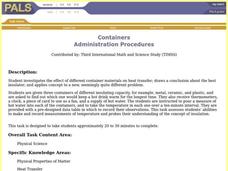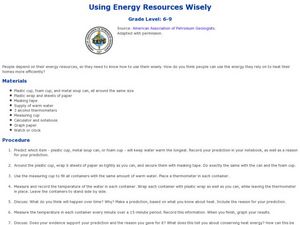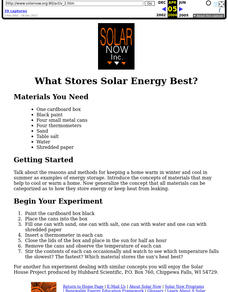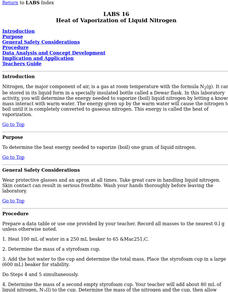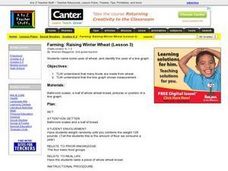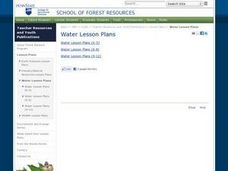Curated OER
Estimating Altitude of Water Cloud Base
Young scholars conduct an experiment to determine dew point and use a formula to detemine altitude. They construct a chart and predict what altitude clouds would form, given the dew point on the ground.
Curated OER
Quick Freeze (Demonstration)
Students witness an demonstration in which a bottle of club soda will go from a liquid to a solid when it is opened and the carbon dioxide is allowed to escape. This will help them understand that the freezing point of a solution will...
Curated OER
Classifying Rocks
Students classify rocks into groups after they observe the rocks and identify properties that can be used to divide them into groups. They then identify other properties that could be used to classify other objects into groups.
Curated OER
Containers
Students investigate the effect of different container materials on heat transfer; draws a conclusion about the best insulator; and applies concept to a new, seemingly quite different problem.
Curated OER
Measurement: Using the balance
Students use a balance and gram cubes to measure several different objects. They then record their results on a data chart and answer questions about them.
Curated OER
Measurement: Length, volume, and temperature
Young scholars determine the temperature of the water in a cup, measure the length of a piece of cardboard, and measure out an appropriate volume of water. This task assesses student's abilities to perform measurement and reporting skills.
Curated OER
Weather Where We Are
Students investigate the reports of local weather. They identify types of weather data and correlate it to the conditions. Using the data students draw a picture of the current weather. They conduct the same investigation for all four...
Curated OER
Daily Survival Requirements of Water
Students will use inquiry science to complete an investigation. They create hypotheses predicting the changes water undergoes in becoming ice and determine how much ice needs to be melted to create one 8 oz. glass of water.
Curated OER
Recycling Garden Waste
Students experience how to make compost. This lesson is ongoing with periodic checks and maintenance. They select a piece of ground around the school or around their homes to establish a compost pile. Organic materials are utilized...
Curated OER
American Quilts
Third graders are introduced to new vocabulary associated with slavery and the Underground Railroad. In groups, they use the vocabulary to identify the various ranges of freedom and create their own vocabulary webs. To end the lesson,...
Curated OER
Heat Absorption
Students examine how heat moves from substance to another. In this heat absorption instructional activity students identify ways that heat is transferred and analyze data.
Curated OER
Using Energy Resources Wisely
Students discuss energy resources. In this energy lesson, students predict which item: the plastic cup, metal soup can, or foam cup, will keep water warm for the longest time by measuring the temperature in each item every minute for 15...
Curated OER
Measurement: When Degrees Matter
Eighth graders record the temperature change of the beakers. In this general science lesson, 8th graders create their own data table for recording observations. They discuss experimental results and cite real life applications.
Curated OER
Texas Estuary Project
Students practice the proper lab techniques of coring, seining, taking temperatures, and salinity. Students analyze and graph data. Students write a 3 part essay and correctly draw and label a food web of their field site.
Curated OER
Weather Around the World
Students learn a few key weather terminology and a variety of climates through examining and recording weather characteristics in a variety of communities around the world.
Curated OER
Organs to Go...
Young scholars explain the principles of experimental design and reinforce the steps of the scientific method. Each group of students create a "slush" type mixture to store a chicken liver.
Curated OER
What Stores Solar Energy Best?
Students discuss reasons and methods for keeping a home warm in winter and cool in summer as examples of energy storage. Students participate in a solar energy experiment.
Curated OER
Why Don't Whales Have Legs?
Students are given a variety of materials and are asked to design a heat loss experiment that results in a reasonable explanation of "Why don't whales have legs?" students work with the theory of natural selection.
Curated OER
Heat of Vaporization of Liquid Nitrogen
Students determine the heat energy needed to vaporize (boil) one gram of liquid nitrogen.
Curated OER
Let There Be Light
Students observe that different lights have different effects on matter. Students see that ultraviolet light is powerful although it cannot be seen through this teacher led demo-experiment.
Curated OER
Farming: Raising Winter Wheat (Lesson 3)
Students identify foods that are made from wheat. They use a line graph to explain measurement. They identify foods from the food groups and explain how temperature, prefcipitation and natural resources affect the growth of wheat.
Curated OER
Vectors
Learners use both magnitude and direction to locate a place. They use locating techniques to make a temperature field of their classroom.
Curated OER
Investigation 6 - Collecting Weather Data
Fourth graders collect data for two weeks. They start seeing patterns and make predictions. They can predict what the weather be like the next day and for the next few days. They see if their predictions were correct from the previous day.
Curated OER
"Pennsylvania Watersheds, Many Ways to the Sea"
Students trace a molecule of water through the water cycle including each of its three loops. They describe why evapotranspiration demands the largest portion of total precipitation falling on a forested watershed.
Other popular searches
- Thermometer Worksheet
- Feelings Thermometer
- Reading a Thermometer
- Reading Thermometers
- Fahrenheit Thermometer
- Floating Thermometer
- Celsius Thermometer
- Blank Thermometer
- Thermometer Reading
- Using a Thermometer
- Weather Using Thermometer
- Reading Thermometers Math


